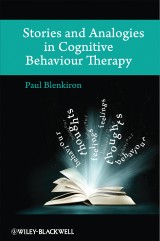Details

Stories and Analogies in Cognitive Behaviour Therapy
1. Aufl.
|
49,99 € |
|
| Verlag: | Wiley-Blackwell |
| Format: | |
| Veröffentl.: | 23.09.2011 |
| ISBN/EAN: | 9780470060001 |
| Sprache: | englisch |
| Anzahl Seiten: | 416 |
DRM-geschütztes eBook, Sie benötigen z.B. Adobe Digital Editions und eine Adobe ID zum Lesen.
Beschreibungen
An accessible guide to employing stories and metaphors within cognitive behaviour therapy, which will aid clinicians in providing effective treatment for their clients <ul> <li>Provides therapists with a range of metaphors that can be employed as a tool to enable clients to gain a new perspective on their problem, and reinforce their clients’ motivation for change</li> <li>CBT (Cognitive Behaviour Therapy) continues to grow in popularity, and is strongly recommended as an effective intervention by the National Institute of Clinical Excellence</li> <li>Written in an engaging style that is accessible to both established practitioners and trainees in clinical psychology</li> </ul>
List of Tables, Figures and Boxes. <p>About the Author.</p> <p>Foreword by Chris Williams.</p> <p>Preface.</p> <p>Acknowledgments.</p> <p><b>PART ONE: ONCE UPON A TIME: GETTING STARTED.</b></p> <p><b>Chapter 1: What is Cognitive Behaviour Therapy?</b></p> <p>Introduction.</p> <p>What Is Psychotherapy?</p> <p>What Is Cognitive Behaviour Therapy?</p> <p>CBT: Ten Essential Ingredients.</p> <p>Ten Common Myths About CBT.</p> <p>Summary.</p> <p><b>Chapter 2: Stories, Analogies & Metaphors.</b></p> <p>Introduction.</p> <p>Tools for Communication.</p> <p>Stories from the Wider World.</p> <p>Story-Telling across the Psychotherapies.</p> <p>Summary.</p> <p><b>Chapter 3: Using Stories in CBT.</b></p> <p>Introduction.</p> <p>Uses for Stories and Metaphors.</p> <p>Abuses and Limitations.</p> <p>The Evidence Base.</p> <p>Drawing it All Together.</p> <p>Summary.</p> <p><b>PART TWO: DEVELOPING THE PLOT: STORIES FOR SPECIFIC DISORDERS.</b></p> <p><b>Chapter 4: Depression.</b></p> <p>Introduction.</p> <p>Definition.</p> <p>Stories and Analogies.</p> <p>Step 1: Putting it into Words.</p> <p>Step 2: Accepting Help.</p> <p>CBT for Depression.</p> <p>Step 3: Doing More - Activities and Goals.</p> <p>Three Layers of Thinking.</p> <p>Step 4: Removing the Critical Voice.</p> <p>Step 5: Develop a Kinder Self-Talk.</p> <p>Step 6: Preparing for the Future.</p> <p>Summary.</p> <p><b>Chapter 5: Anxiety, Panic and Phobias.</b></p> <p>Introduction.</p> <p>What Is Anxiety?</p> <p>How Do We Learn?</p> <p>Assessing Anxiety.</p> <p>Generalised Anxiety Disorder.</p> <p>Panic Disorder.</p> <p>Catastrophic Misinterpretation.</p> <p>Selective Attention.</p> <p>Hypervigilence.</p> <p>Safety Behaviours.</p> <p>Phobias.</p> <p>Graded Exposure.</p> <p>Social Anxiety.</p> <p>Summary</p> <p><b>Chapter 6: Obsessions, Compulsions and Post Traumatic Stress.</b></p> <p>Introduction.</p> <p>Obsessive Compulsive Disorder.</p> <p>Definition.</p> <p>Behaviour Therapy for OCD.</p> <p>Cognitive Therapy for OCD.</p> <p>Post Traumatic Stress Disorder.</p> <p>Definition.</p> <p>Stories and Analogies for PTSD.</p> <p>CBT for PTSD.</p> <p>Exposure Therapy for PTSD.</p> <p>Cognitive Therapy for PTSD.</p> <p>Childhood Trauma.</p> <p>Summary.</p> <p><b>Chapter 7: Physical Health.</b></p> <p>Introduction.</p> <p>Health Anxiety.</p> <p>Medically Unexplained Symptoms.</p> <p>Chronic Fatigue Syndrome.</p> <p>Eating Disorders.</p> <p>Adjusting to Serious Illness.</p> <p>When Illness Threatens Life.</p> <p>Summary.</p> <p><b>Chapter 8: Personality, Beliefs And Behaviours.</b></p> <p>Introduction.</p> <p>Anger.</p> <p>Assertiveness.</p> <p>Low Self-Esteem.</p> <p>Relationship Problems.</p> <p>Self-Harm.</p> <p>Perfectionism.</p> <p>Changing Core Beliefs.</p> <p>Summary.</p> <p><b>PART THREE: HAPPILY EVER AFTER? STORY-TELLING IN THE REAL WORLD.</b></p> <p><b>Chapter 9: CBT In Practice.</b></p> <p>Introduction.</p> <p>Practical Tips For Therapists.</p> <p>Creating Personalised Stories and Analogies.</p> <p>Problem Solving.</p> <p>Schizophrenia and Psychosis.</p> <p>Teamwork, Training and CBT Supervision.</p> <p>Summary.</p> <p><b>Chapter 10: The Next Generation.</b></p> <p>Introduction.</p> <p>Third-Generation CBT.</p> <p><b>Behavioural Activation.</b></p> <p><b>Mindfulness.</b></p> <p>Acceptance and Commitment Therapy.</p> <p>CBT for Enduring Problems.</p> <p>Compassionate Mind Training.</p> <p>Building Resilience.</p> <p>The New You.</p> <p>The Future of CBT.</p> <p>Summary.</p> <p><b>Epilogue: The End - An Unfolding Story...</b> </p> <p><b>Appendices.<br /> </b></p> <p>Appendix 1: Sources of Information for this Book.</p> <p>Appendix 2: Literature Search.</p> <p>Appendix 3: List of Therapy Conversations.</p> <p>Appendix 4: List of Stories and Analogies.</p> <p>Author’s Note.</p> <p>References.</p> <p>Index.</p>
<p>“Story telling is one of our most ancient ways of communicating. Paul Blenkiron has vividly described how stories can be used for therapeutic purposes.” (CBT Today, March 2015)</p> <p> “An excellent, stimulating book. Offers all therapists an invaluable toolkit for many years to come. I recommend savouring every word." (Royal College of Psychiatrists, 2 February 2011)</p> <p>“This is a real treat and worth an investment - not only for ‘the shelf’, but also for the 'self’" (British Association for Behavioural & Cognitive Psychotherapies, 15 December 2010 )</p> <p>"What makes this book such a coherent piece of work is its structured presentation of useful content paired with the well-thought-out narrative in which these ideas are communicated." (Psychologist, 1 October 2010)</p> <p>“The usefulness of this book to therapeutic practice is vast.” (Therapeutic Recreation, 1 July, 2010)</p>
<b>Paul Blenkiron</b> is a Consultant Psychiatrist based at Bootham Park Hospital in York, UK, and is an accredited member of the British Association for Behavioural and Cognitive Psychotherapies. He is also Honorary Senior Lecturer in Psychiatry and Behavioural Sciences at Leeds University, and a CBT course facilitator at York University’s Department of Health Sciences. He has authored more than 60 original research and clinical publications in the areas of CBT, depression, self harm and chronic fatigue.
Cognitive Behaviour Therapy (CBT) is a popular psychological treatment for many common mental health problems. While its effectiveness is based on solid empirical evidence, to apply CBT techniques successfully in a real world setting, clinicians must engage and inspire the individuals they are treating. Narrative is a powerful communication tool that can greatly aid in this endeavor. <i>Stories and Analogies in Cognitive Behaviour Therapy</i> teaches practical CBT by employing relevant stories, metaphors, analogies, quotations, and anecdotes. The book also demonstrates how practitioners can use the examples described with their clients and patients. <p>Based on the accrued wisdom of the author and many other leading CBT practitioners, <i>Stories and Analogies in Cognitive Behaviour Therapy</i> provides clinicians with a well organized, accessible guide to facilitate effective change within the therapy session.</p>
Diese Produkte könnten Sie auch interessieren:

The Wiley-Blackwell Handbook of Childhood Social Development

von: Peter K. Smith, Craig H. Hart

136,99 €
















